Arm Home Workout: Sculpt Lean Arms Without Weights and Boost Results With Keto Recovery
This post may contain affiliate links. If you purchase through these links, I may earn a small commission at no extra cost to you. LEARN MORE.
Sculpting lean, toned arms at home does not require fancy equipment or gym memberships.
Anyone can build strength and definition using simple bodyweight exercises and the right nutrition for recovery.
This approach is easy to start and can fit into even the busiest schedules.

Effective arm workouts can be done without lifting weights, using moves like push-ups, tricep dips, or arm circles.
For better results after exercise, those following a keto diet can focus on foods that support muscle repair and reduce soreness.
Start your transformation with a Custom Keto Diet Plan tailored to fuel lean muscle sculpting without added bulk.
Key Takeaways
- Simple bodyweight moves build arm strength without equipment.
- Proper form and recovery are vital for results and safety.
- A keto-friendly diet can aid in muscle repair after workouts.
Benefits of Arm Home Workouts Without Weights
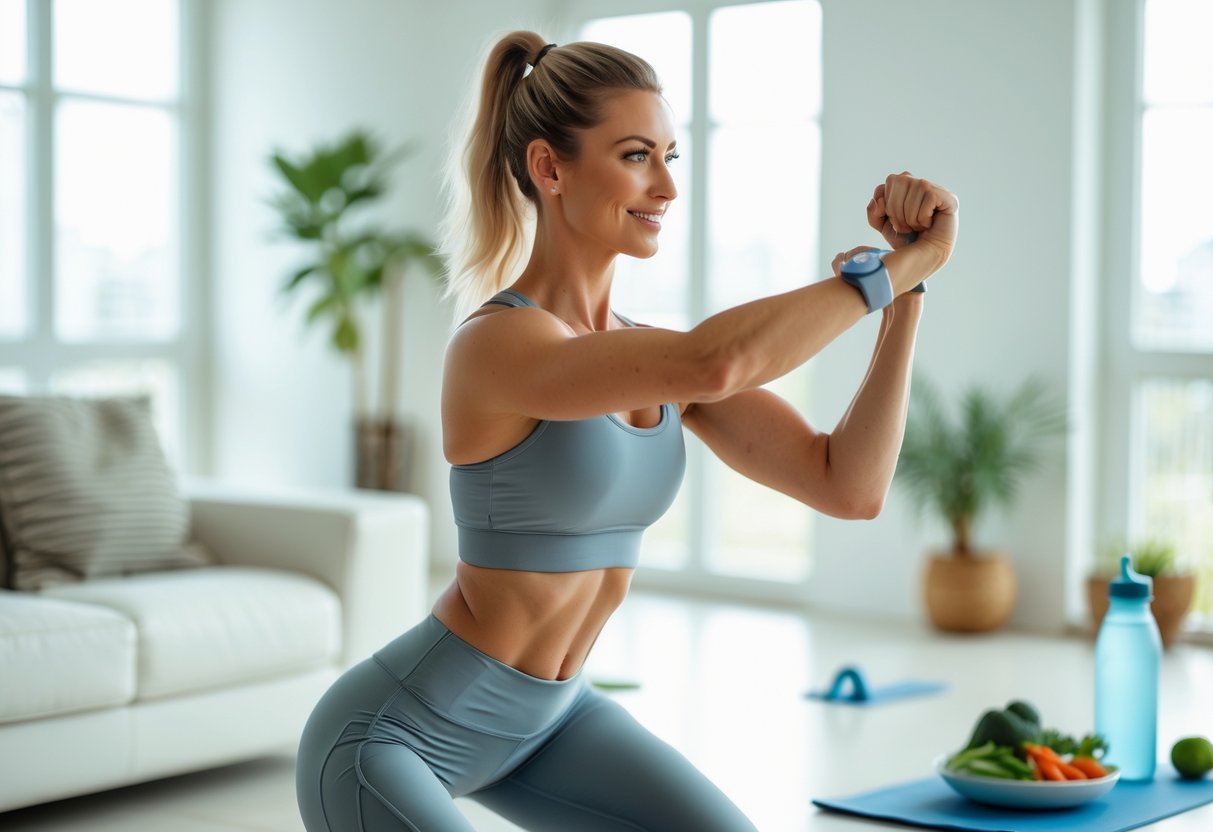
Arm workouts without weights offer several practical benefits.
They can help people tone their arms, support fat loss, and build lean muscle right at home, using just their body weight.
Advantages Over Traditional Weight Training
Arm home workouts do not require any equipment, making them easy for anyone to start.
People can use their own body weight with moves like push-ups, tricep dips, and planks.
Workouts without weights are often safer, since there is less risk of dropping heavy objects or straining the muscles with too much weight.
This makes it easy for beginners or those with joint concerns.
Because these workouts use natural movements, many exercises also work the chest, core, and shoulders.
This helps improve real-life strength and supports coordination.
Arm workouts without weights are also flexible—they can be done anywhere and do not need much space.
For busy people or those without access to a gym, this makes fitness more convenient and accessible.
Unlike heavy gym lifts, bodyweight routines like those in our Chest Home Workout reduce joint strain while still challenging your muscles.
Muscle Toning and Fat Loss
Bodyweight arm workouts help target flabby arms and can contribute to overall fat loss, since they often include high-rep moves that keep the heart rate up.
For example, fast-paced planks or arm circles are simple but effective ways to stay moving.
Toning comes from consistent movement that works the muscles while also burning calories.
With regular practice, these exercises may make the arms look more defined and feel stronger.
No equipment also means more chances to add variety—rotating between different moves like wall push-ups, chair dips, and side planks can prevent plateaus and keep muscles challenged.
Key points:
- Burns fat with higher heart rates
- Improves muscle definition over time
- Targets stubborn arm fat with focused moves
Building Lean Arm Muscles
To develop lean arm muscles at home, workouts without weights rely on the body for resistance.
Slow and controlled movements, including negatives (the lowering part of each rep), can increase muscle engagement.
Doing high repetitions helps muscles adapt and look lean rather than bulky.
Movements like triceps dips or extended-arm planks strengthen the triceps, biceps, and shoulders in one session.
This approach supports a toned appearance without making the arms bigger than desired.
Since it does not use heavy weights, it works well for people aiming to shape and firm the arms while keeping them slim.
Switching up exercises regularly can help target every part of the upper arm:
- Push-ups: chest, triceps, and shoulders
- Arm circles: shoulders, biceps, and triceps
- Planks: whole arm and core
Like our Keto and Strength Training for Women guide recommends, lean mass comes from consistency—not lifting heavy.
Essential Bodyweight Arm Exercises
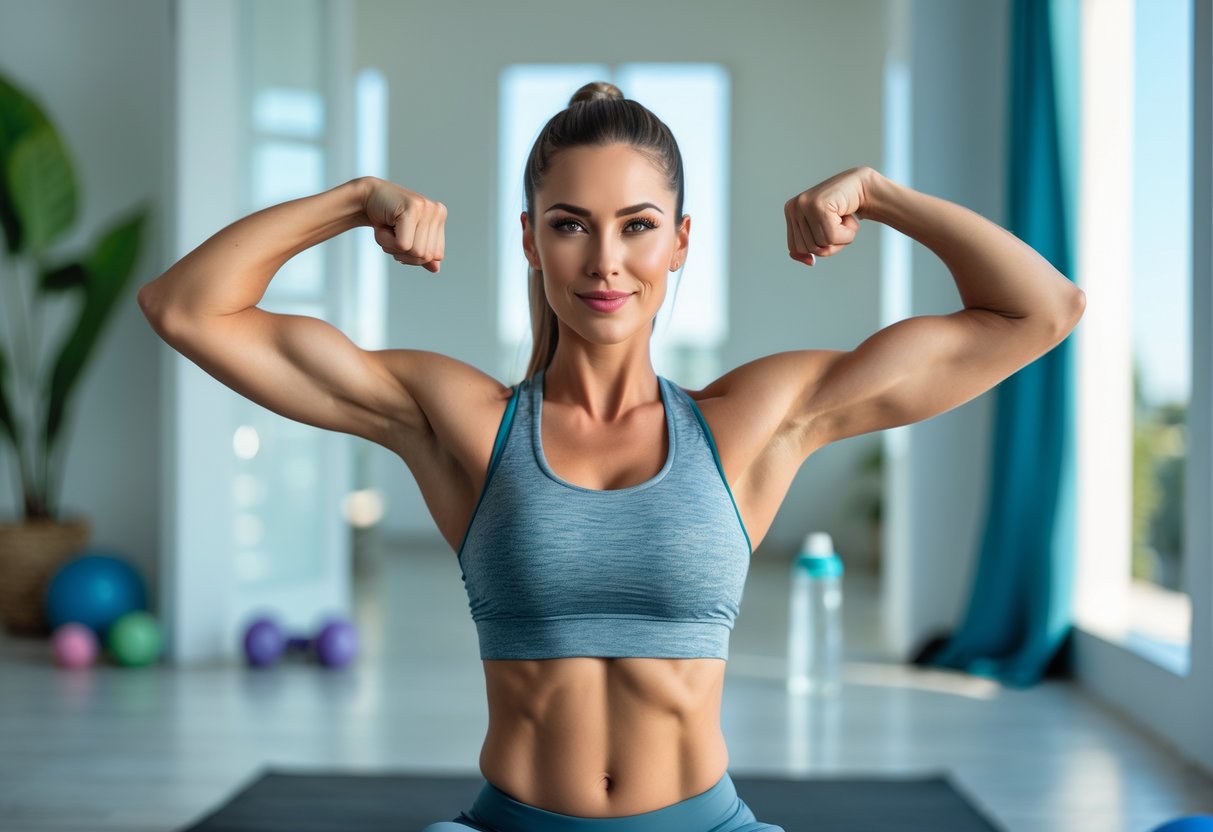
Bodyweight exercises for the arms are a practical choice because they do not require any equipment and can be performed almost anywhere.
These movements target major muscle groups in the arms and shoulders, helping to build strength and definition through consistent practice and correct form.
Push-Up Variations
Push-ups are a classic calisthenics exercise that works the chest, shoulders, and triceps.
They also engage the core to keep the body stable during movement.
There are several push-up variations that make the workout more challenging or accessible.
Regular push-ups use the palms and toes to support the body.
Knee push-ups are a good starting point for beginners, as they lighten the load on the arms.
Diamond push-ups bring the hands together under the chest in a diamond shape, shifting the focus to the triceps.
This variation increases the difficulty and isolates the back of the arms more than standard push-ups.
Try adding sets of each variation to target the arms from different angles.
Use slow, controlled motion with proper form to avoid strain.
Push-ups also activate core and shoulders, as detailed in our Shoulder Home Workout.
Dips and Triceps Dips
Dips, especially triceps dips, are effective for targeting the back of the arms and shoulders.
They require a stable surface, like a chair or a sturdy low table.
To perform a triceps dip, start seated with hands next to the hips, fingers facing forward.
Slide the hips off the edge, supporting the body with the arms.
Lower the body by bending the elbows, then push up to the start position.
For added difficulty, extend the legs out further or raise one leg at a time.
Dips challenge the triceps, chest, and shoulders without the need for weights.
Aim for controlled movements and avoid letting the shoulders hunch.
Arm Circles and Shoulder Taps
Arm circles are a simple bodyweight exercise that helps strengthen the shoulders, upper arms, and increase blood flow.
Stand with arms extended at shoulder height and move them in small, controlled circles, first forward, then backward.
Shoulder taps are performed from a high plank position.
Tap one shoulder with the opposite hand, alternating sides.
This move targets the shoulders, triceps, and core stability.
Both exercises are low-impact and helpful in warming up the arm muscles before more demanding moves.
They can be included as part of a daily routine to improve endurance and joint health.
Plank-Based Arm Movements
Plank exercises use bodyweight to build arm and core strength at the same time.
The high plank position, with hands under shoulders, works the arms isometrically.
The forearm plank shifts some tension to the lower arms and core.
Variations like the lateral plank walk—moving side to side while maintaining a plank—challenge the shoulders, arms, and coordination.
Inchworms start from standing, then move hands out to a plank and walk feet forward, involving the entire upper body.
These moves require stability and help develop strength using only bodyweight, making them effective for arm workouts without equipment.
Boost stubborn fat loss around arms naturally—add Java Burn, a metabolism-supporting morning drink.
Customizing Your At-Home Arm Workout Routine
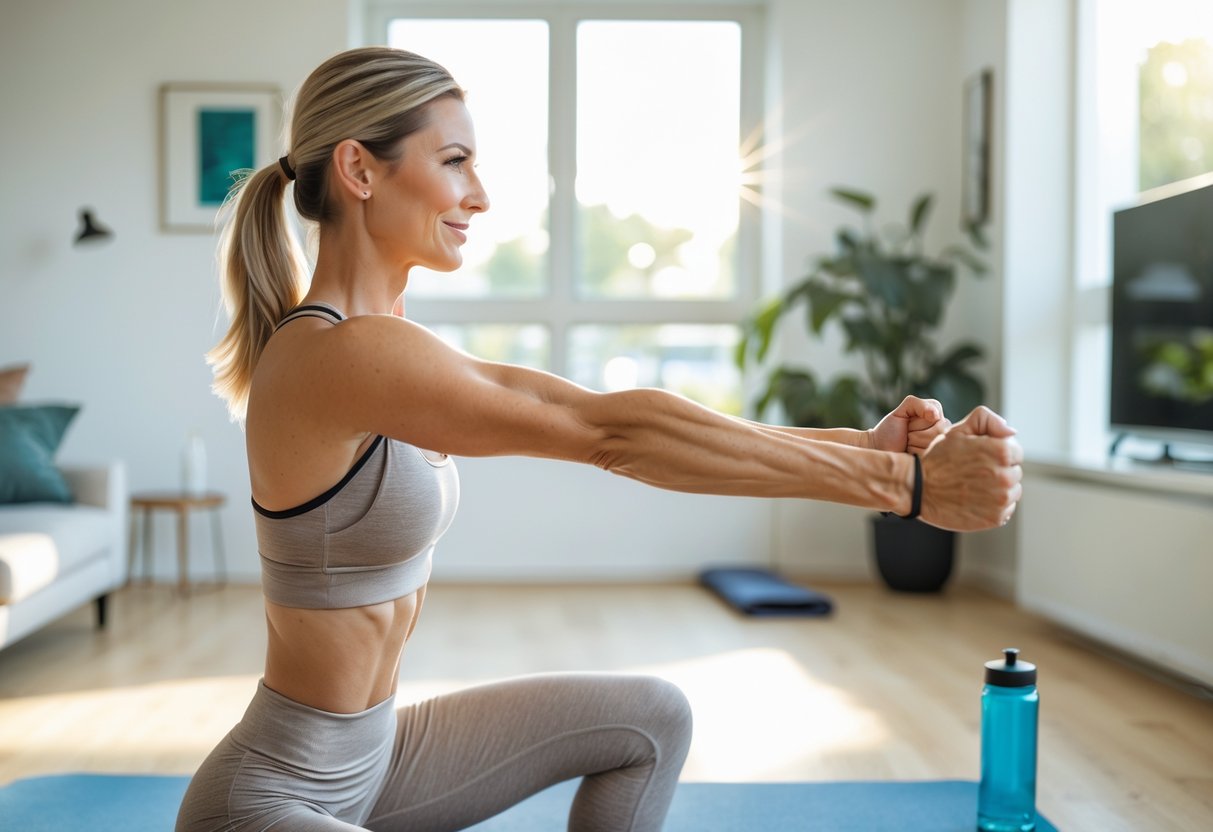
Choosing the right workout routine depends on the person’s goals, fitness level, and space.
Building arm muscles, losing arm fat, and increasing upper body strength are possible without equipment by using smart exercise choices and good planning.
Structuring a Balanced Upper Body Session
Effective home workouts for arms should target all main muscle groups.
This means training the biceps, triceps, shoulders, and upper back.
It’s best to mix push and pull moves like push-ups, tricep dips, and bodyweight rows.
Here is a basic session structure:
| Exercise | Muscles Worked | Sets | Reps |
|---|---|---|---|
| Push-ups | Chest, triceps, front shoulders | 3 | 10-15 |
| Tricep Dips | Triceps, shoulders | 3 | 8-12 |
| Plank Shoulder Taps | Core, shoulders | 3 | 15-20 taps |
| Bodyweight Rows (under table/chair) | Back, biceps | 3 | 8-12 |
| Bicep Curls (with towels/backpack) | Biceps | 3 | 10-15 |
Rest for 30-60 seconds between sets.
Focus on proper form to avoid injury and maximize muscle gains.
For lower body balance, try the routines from our Home Workout Leg Exercise Guide.
Adapting for All Fitness Levels
People starting out should try wall push-ups or knee push-ups before moving to standard forms.
Beginners can use shorter sessions and fewer sets, while still working toward arm fat loss and better strength.
Intermediate and advanced exercisers can add slow negatives, extra repetitions, or do more challenging variations such as diamond push-ups or single-arm planks.
If someone needs more resistance, household items like backpacks loaded with books can help.
Adjusting the difficulty keeps motivation high and muscle mass growing for all fitness levels.
Progressing Without Equipment
Without weights, progress can come from simple changes.
Try increasing repetitions, slowing down each move, or cutting down rest times.
For example, pause at the hardest part of each rep to make muscles work longer.
Weekly, add more sets or try a new exercise.
Track progress with a journal or phone app.
Rotating exercises—such as switching from tricep dips to close-grip push-ups—prevents boredom and challenges the muscles in new ways.
Optimizing Form and Injury Prevention
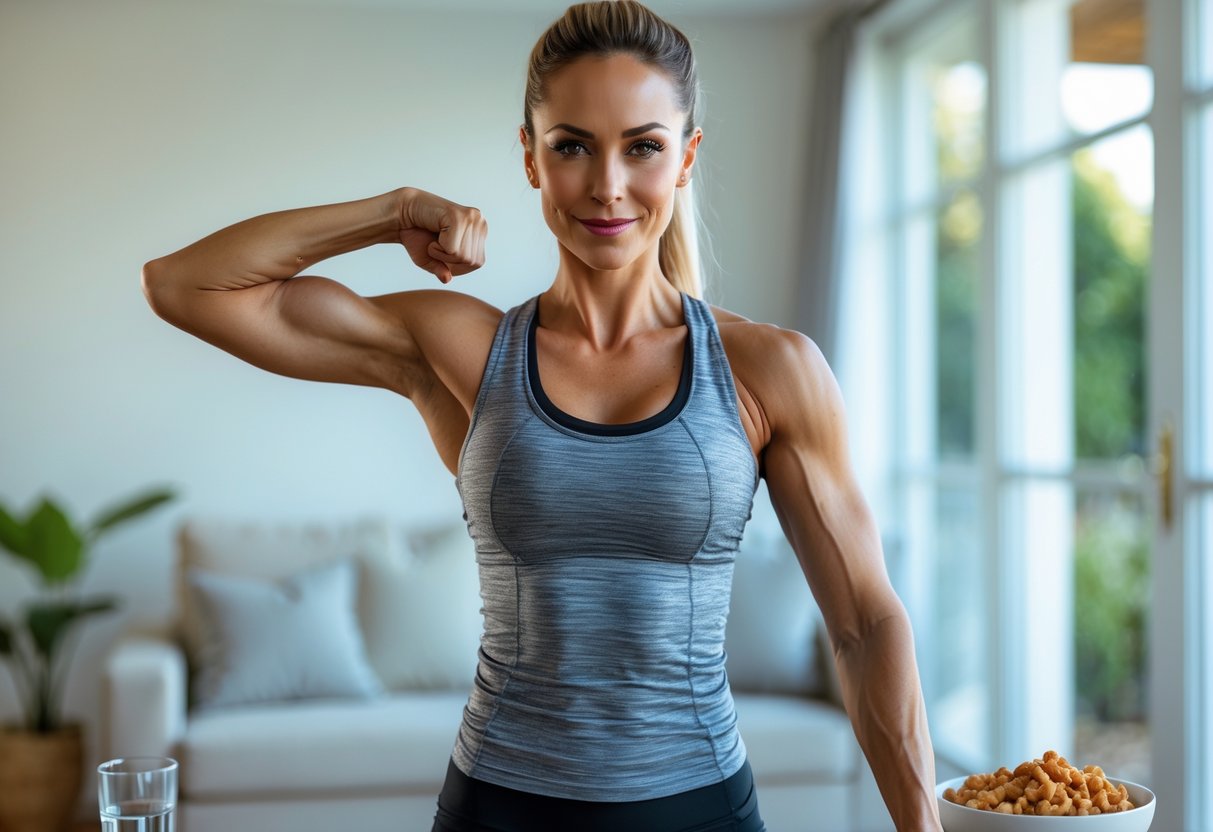
Using the right technique is key to seeing results and staying injury-free during arm workouts at home.
Good habits also make each exercise more effective, especially when no equipment is involved.
Small mistakes can lead to wrist or joint pain, so learning to move the right way matters.
Mastering Proper Technique
Proper form during resistance training is crucial.
For exercises like push-ups, triceps dips, or the overhead press (when done without weights or with wrist weights), alignment is everything.
Elbows should not flare out too far in bodyweight moves.
The core must stay engaged, and backs should be flat instead of arched or sagging.
In an overhead press, arms should rise in line with the shoulders—not in front or behind—and wrists must stay straight.
Repetition is important for form.
Practicing in front of a mirror or recording a session can help spot mistakes early.
Correct form builds strength, prevents injuries, and ensures all the right muscles get worked.
Common Mistakes and How to Avoid Them
Many people bend their wrists too much or lock their elbows during exercises like planks or push-ups. This can strain joints and lead to discomfort.
Common mistakes include:
- Dropping hips or arching back during planks
- Letting elbows flare out in push-ups or dips
- Using momentum instead of slow, controlled movements
To avoid these, focus on:
- Keeping wrists, elbows, and shoulders aligned
- Moving slowly and using control
- Stopping an exercise if form falters, even if the set is not complete
Wrist and Joint Support
Supporting the wrists and other joints is crucial for bodyweight arm workouts. Certain moves, especially floor exercises, put a lot of pressure on wrists.
Tips for protection include:
- Wrist weights can add resistance while keeping hands free, but they should be used only if wrists are strong and pain-free.
- Avoid overextending joints or locking them during resistance training.
- Use a mat for better grip and softer surface.
If any pain or discomfort arises, it’s best to rest.
Even small adjustments, like making a fist instead of having flat palms during push-ups, can help relieve wrist pressure.
Regular stretching for wrists, elbows, and shoulders before and after exercise helps maintain joint health.
Enhance your performance and recovery with the Nagano Tonic – designed to support metabolism and reduce inflammation naturally.
Keto Recovery Support After Arm Home Workout
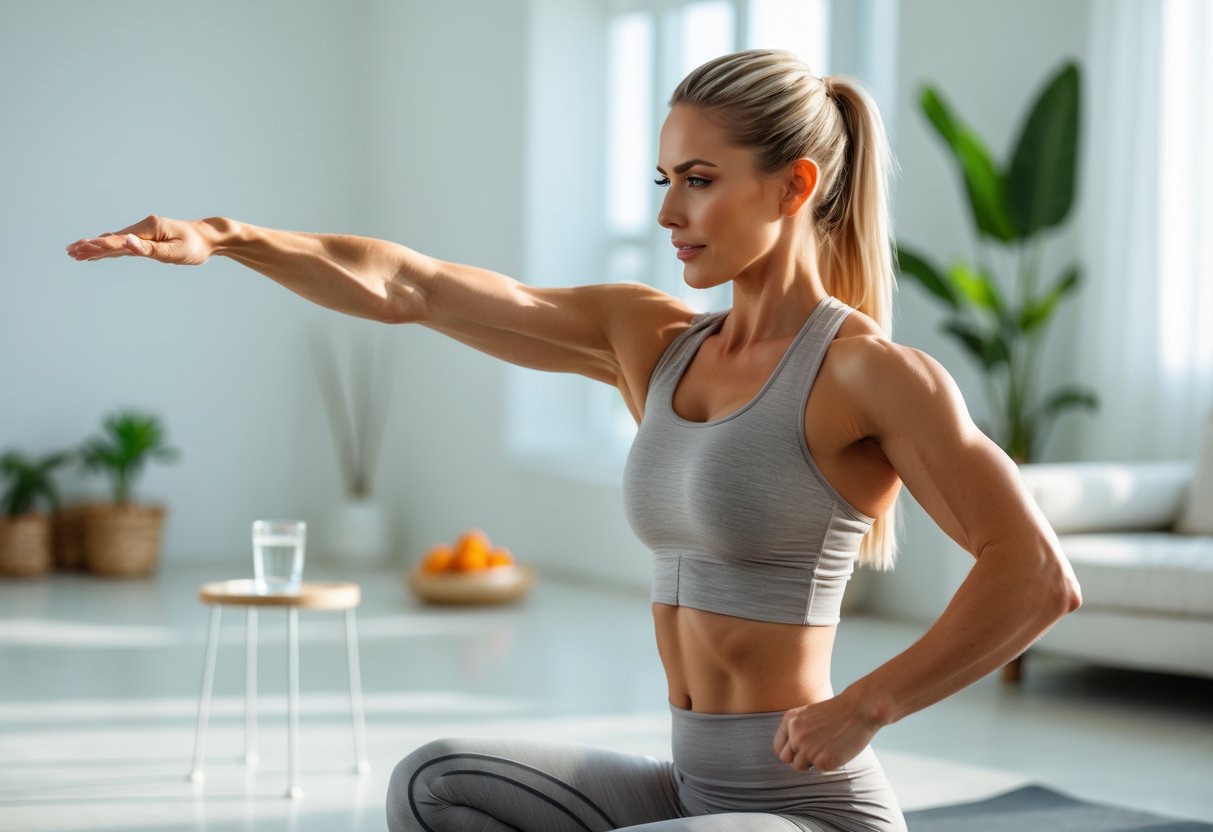
Recovering after an arm workout requires the right fuel and hydration, especially when following a keto diet.
Focusing on muscle repair, maintaining lean muscle mass, and preventing cramps can make recovery more effective and comfortable.
Keto Diet Basics for Muscle Recovery
The keto diet is low in carbohydrates and high in fats, with moderate protein.
After exercise, the body uses fat and protein to repair and build lean muscles because carbs are limited.
Foods like eggs, salmon, chicken, and nuts provide the protein muscles need for recovery.
Healthy fats, such as avocado and olive oil, help lower inflammation.
Since keto limits carbs, the body shifts to using fats for energy, which can lead to less muscle soreness after workouts.
It’s important to keep protein intake high enough.
Most people aim for around 1.2 to 2.0 grams of protein per kilogram of body weight to repair and support muscle mass.
Not eating enough protein may slow recovery or cause muscle loss.
Refer to Top Muscle Recovery Foods That Speed Up Healing for full keto-aligned options that promote repair.
Post-Workout Nutrition Tips
Eating soon after an arm workout helps muscle recovery.
On keto, focus on these post-workout foods:
- Grilled chicken or turkey
- Cottage cheese
- Nuts or seeds
- Greek yogurt (unsweetened)
Add a serving of non-starchy vegetables, like spinach or bell peppers, for extra vitamins and minerals.
These choices help the body repair muscle fibers and maintain lean muscle mass without spiking blood sugar.
It can also help to include a small amount of low-sugar fruit, such as berries, if extra energy is needed, but keep portions modest.
Supplements, like a keto-friendly protein shake or amino acids, can fill nutrition gaps if food choices are limited.
Hydration and Electrolyte Balance
Staying hydrated is essential for muscle recovery and overall health on keto.
The body loses more water and electrolytes, especially sodium and potassium, on a low-carb diet.
This can lead to muscle cramps or weakness after exercise.
After an arm workout, drink water regularly throughout the day.
Add a pinch of salt or a keto-friendly electrolyte supplement to a glass of water to help replace lost minerals.
Coconut water (unsweetened) or bone broth are good options for extra electrolytes.
Maintaining a steady intake of magnesium, found in leafy greens and seeds, also supports healthy muscles and may reduce soreness.
Keeping hydration and electrolyte levels balanced can speed up recovery and improve workout results.
For more information, check our guide on Best Electrolytes for Keto Diet: Prevent Fatigue and Cramps.
Long-Term Motivation and Sustainable Progress
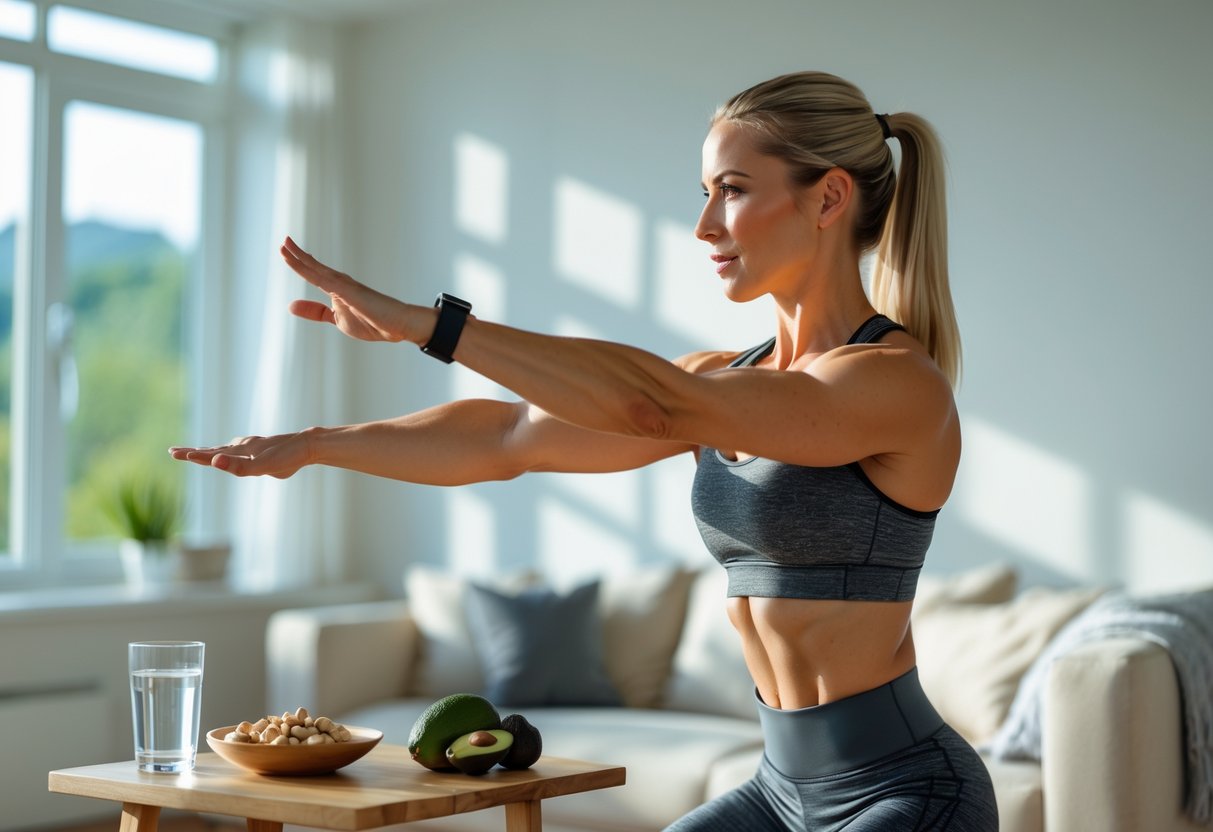
Maintaining motivation and seeing lasting progress with arm workouts at home takes more than just starting strong.
Tracking results, staying accountable, and knowing how to push past plateaus help keep workouts effective and enjoyable.
Tracking Results and Staying Accountable
Consistent tracking helps people see how much they improve over time.
They can use a simple table, notebook, or app to log sets, reps, and how they feel after each session.
Seeing small changes, like doing more push-ups or using better form, can boost motivation.
Table: Example Progress Tracker
| Date | Exercise | Sets x Reps | Notes |
|---|---|---|---|
| June 1 | Push-ups | 3×10 | Felt challenging |
| June 8 | Push-ups | 3×14 | Less difficult |
Accountability also helps.
Setting reminders or sharing goals with friends or online groups increases the chance of sticking with the routine.
Progress photos every two weeks can show changes not always visible in the mirror.
Overcoming Plateaus and Staying Motivated
Plateaus happen when progress seems to stop.
Changing up the routine helps break through.
This could mean trying new exercises, changing the order, or adding more reps.
Focusing on form and slowing down each movement can make exercises harder without any weights.
Setting new, clear goals encourages steady effort.
For example, aiming for 20 good-form dips in a row or holding a plank longer.
Celebrating any progress, no matter how small, helps people stay motivated.
Listening to music or joining a challenge online gives extra encouragement for continuing arm workouts at home.
Learn from our guide on Breaking Through Keto Plateaus: Advanced Strategies to Restart Your Weight Loss Journey.
Frequently Asked Questions
Simple bodyweight exercises can help tone and shape arm muscles at home.
Using a ketogenic diet for recovery requires attention to specific nutrients and strategies.
What are some effective arm toning exercises for women at home?
Common exercises include push-ups, tricep dips using a chair, and plank-to-push-up transitions.
Arm circles and wall push-ups also target arm muscles without equipment.
These moves help strengthen and define the biceps, triceps, and shoulders.
Can you recommend a quick arm workout that doesn’t require equipment?
A 10-15 minute routine can include arm circles (1 minute), push-ups (30 seconds), tricep dips (1 minute), plank shoulder taps (1 minute), and a short rest.
Repeat 2-3 times.
This routine works the main muscles in the arms with only body weight.
How can females shape their arms without gaining bulky muscles?
Doing higher repetitions with lower resistance, like bodyweight exercises, helps build muscle tone but not bulk.
Focusing on steady, controlled movements improves endurance and definition.
Eating enough protein supports muscle health without adding unwanted size.
What’s a good strategy to lose arm fat within a week?
While it isn’t possible to target fat loss to only the arms in one week, regular exercise and a calorie deficit support overall fat loss.
Adding arm-focused workouts with cardio and healthy eating can help reduce body fat over time.
Are there any specific workouts for slimming arms that don’t use weights?
Yes.
Arm circles, wall push-ups, tricep dips, and plank taps effectively engage arm muscles without the need for added weights.
These exercises help tone the arms when included in a consistent routine.
What are some post-workout recovery tips for a keto diet after an arm workout?
After working out, people following keto should drink water and get enough electrolytes, such as salt and potassium.
Eating lean protein sources, like chicken or eggs, aids muscle repair.
Adding healthy fat sources, such as avocado or olive oil, helps meet energy needs without carbs.
Conclusion
Regular arm workouts at home can help build strength and muscle tone without any equipment.
Bodyweight exercises like push-ups, tricep dips, and plank-ups are effective for working different parts of the arms.
Combining exercise with a balanced diet supports muscle growth and recovery.
Some people choose a ketogenic diet for recovery, focusing on healthy fats, moderate protein, and low carbohydrates.
Here’s a quick list to remember:
- Include arm exercises 2-4 times a week
- Pay attention to proper form
- Adjust repetitions to match fitness level
- Rest and recover between sessions
- Eat foods that support muscle repair
Whether new to exercise or looking to upgrade a routine, these steps offer a simple start.
Safe movement and mindful eating are key to steady progress.
Ready to take the guesswork out of your health reboot? Start with a Custom Keto Diet Plan and energize your arms with Java Burn or Nagano Tonic today.
